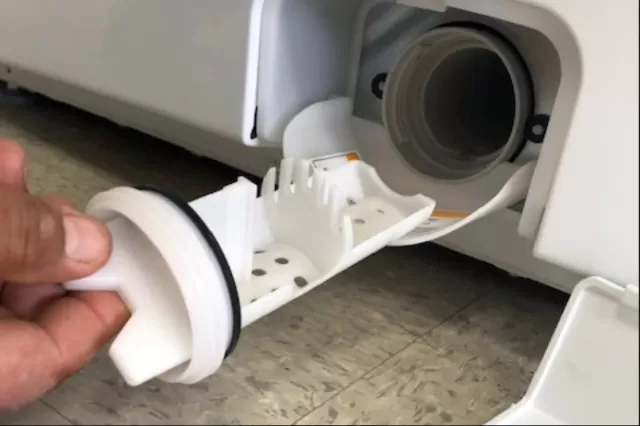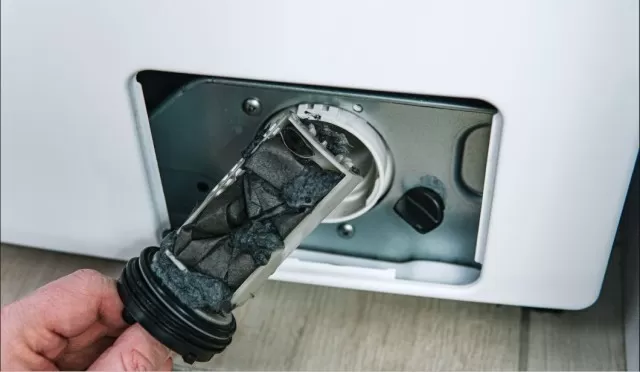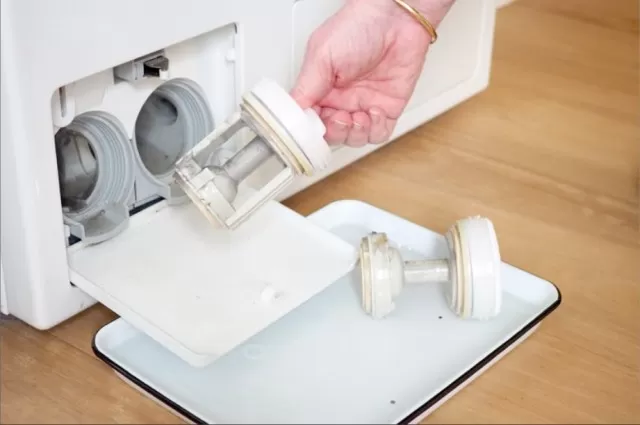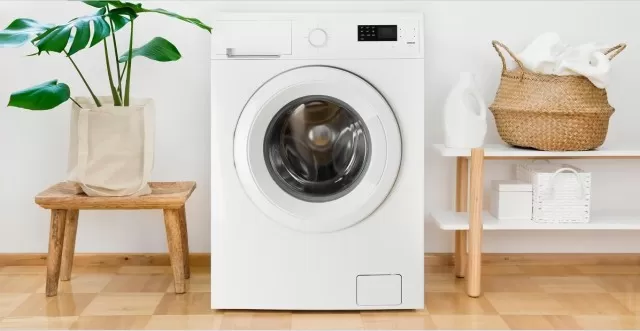Cleaning your washing machine filter is an important maintenance task to keep your machine running smoothly and ensure fresh-smelling laundry.
By regularly cleaning the filter of your washing machine, you can maintain its performance, prevent odors, and keep your laundry fresh and clean.
Locate the Filter

Some newer washing machine models, especially high-efficiency (HE) machines, may not have a traditional filter that needs manual cleaning.
Instead, they may have a self-cleaning filter located within the machine’s pump system. These self-cleaning filters are designed to handle the removal of lint and debris automatically, reducing the need for regular maintenance by the user.
If you have a newer washing machine without a visible filter, it’s likely equipped with a self-cleaning mechanism.
In such cases, it’s important to follow the manufacturer’s instructions regarding maintenance and cleaning, as they may recommend running specific cleaning cycles or using specific cleaning products to keep the machine functioning optimally.
Consulting the owner’s manual or contacting the manufacturer directly can provide you with the most accurate information about the presence and maintenance of a filter in your specific washing machine model.
How Often to Clean the Filter

The frequency of cleaning the washing machine filter can vary depending on the manufacturer’s recommendations and the specific usage patterns.
Here are some general guidelines to consider:
Check the user manual.
The best source of information regarding how often to clean the washing machine filter is the user manual that came with your machine.
It should provide specific instructions and recommendations for maintenance and cleaning.
Monthly or bi-monthly cleaning.
In many cases, it is recommended to clean the washing machine filter once a month or every two months.
This regular cleaning helps prevent lint and debris buildup and ensures optimal performance.
Heavy usage or specific situations.
If you have a large household or frequently wash heavily soiled items, such as work clothes or cloth diapers, you may need to clean the filter more frequently.
Pay attention to the signs mentioned earlier, such as lint buildup on clothes, poor drainage, or unpleasant odors, as they may indicate the need for more frequent cleaning.
Disposable lint traps.
Some washing machines have disposable lint traps rather than reusable filters.
If your machine is equipped with a disposable lint trap, you will need to replace it when it becomes clogged or as recommended by the manufacturer.
Remember, these are general guidelines, and it’s important to refer to the specific recommendations provided by the manufacturer for your particular washing machine model.
Following the recommended maintenance schedule will help keep your washing machine running efficiently and ensure clean, fresh-smelling laundry.
Removable Washing Machine Filter

Wipe the Filter and Housing.
Remove the filter from its housing and use a damp cleaning cloth to wipe away lint and debris.
Also, wipe the filter housing to remove any buildup. Use a flashlight to inspect the filter housing for any hidden debris or clogs.
Place a shallow basin or old towel beneath the filter housing to catch any water that may spill out.
Soak the Filter.
Fill a bucket, bowl, or basin with hot water and add a small amount (about 1 teaspoon) of Dish Soap or liquid laundry detergent.
Submerge the filter in the solution and let it soak for about 10 minutes. This helps to loosen and dissolve any stubborn dirt or residue.
Scrub the Filter.
After soaking, use a soft-bristle brush like an old toothbrush or a dish brush to scrub the filter.
Pay attention to all sides and crevices to ensure thorough cleaning. Gently scrub away any buildup or debris.
Replace the Filter.
Once the filter is clean, place it back into the washing machine’s filter housing.
Ensure that it is securely in place before moving on to the next step.
Run a Short Wash Cycle.
To verify that the filter is properly installed and there are no leaks, run a short wash cycle with no clothes.
Observe the machine during the cycle and check for any leaks. If you notice any leaks, remove the filter and reinsert it securely into the housing.
Regularly cleaning the removable washing machine filter helps maintain proper water flow, prevents clogs, and ensures optimal performance of your washing machine.
Refer to the user manual for your specific machine model for any additional instructions or recommendations.
Fixed Washing Machine Filter

Wipe the Filter and Housing.
Open the filter housing and use paper towels to wipe away any lint and debris that have accumulated on the filter.
Depending on the placement of the filter, place a shallow basin or old towel beneath it to catch any water that may spill out.
Scrub the Filter.
Use a soft-bristle brush, such as an old toothbrush or dish brush, to scrub the filter and remove lint and debris.
Pay attention to all sides and crevices of the filter to ensure thorough cleaning.
Run a Short Wash Cycle.
Once you have cleaned the filter, close the filter housing and run a short wash cycle with no clothes.
This will help to flush out any remaining debris and ensure that the filter is working properly.
Pump Washing Machine Filter

For washing machines that use a self-cleaning pump instead of a removable filter, follow these additional steps:
Run a Short, Empty Wash Cycle: Every 1-3 months, run a short wash cycle without any clothes to flush lint and buildup from the self-cleaning pump.
This helps to keep the machine running properly and prevents clogs.
Regularly cleaning the fixed washing machine filter or running maintenance cycles on machines with self-cleaning pumps helps ensure proper water flow, prevents clogs, and maintains the optimal performance of your washing machine.
Refer to the user manual for your specific machine model for any additional instructions or recommendations.
*The information is for reference only.